[English] 日本語
 Yorodumi
Yorodumi- EMDB-23119: Orexin Receptor 2 (OX2R) in Complex with G Protein and Small-Mole... -
+ Open data
Open data
- Basic information
Basic information
| Entry | Database: EMDB / ID: EMD-23119 | |||||||||
|---|---|---|---|---|---|---|---|---|---|---|
| Title | Orexin Receptor 2 (OX2R) in Complex with G Protein and Small-Molecule Agonist Compound 1 | |||||||||
 Map data Map data | ||||||||||
 Sample Sample |
| |||||||||
 Keywords Keywords | Class A GPCR / Orexin receptor 2 / OX2R / membrane protein / Peptide agonist | |||||||||
| Function / homology |  Function and homology information Function and homology informationregulation of circadian sleep/wake cycle, wakefulness / circadian sleep/wake cycle process / orexin receptor activity / Orexin and neuropeptides FF and QRFP bind to their respective receptors / neuropeptide receptor activity / locomotion / feeding behavior / peptide hormone binding / neuropeptide signaling pathway / regulation of cytosolic calcium ion concentration ...regulation of circadian sleep/wake cycle, wakefulness / circadian sleep/wake cycle process / orexin receptor activity / Orexin and neuropeptides FF and QRFP bind to their respective receptors / neuropeptide receptor activity / locomotion / feeding behavior / peptide hormone binding / neuropeptide signaling pathway / regulation of cytosolic calcium ion concentration / cellular response to hormone stimulus / Olfactory Signaling Pathway / Activation of the phototransduction cascade / G beta:gamma signalling through PLC beta / Presynaptic function of Kainate receptors / Thromboxane signalling through TP receptor / G protein-coupled acetylcholine receptor signaling pathway / Activation of G protein gated Potassium channels / Inhibition of voltage gated Ca2+ channels via Gbeta/gamma subunits / G-protein activation / Prostacyclin signalling through prostacyclin receptor / G beta:gamma signalling through CDC42 / Glucagon signaling in metabolic regulation / G beta:gamma signalling through BTK / Synthesis, secretion, and inactivation of Glucagon-like Peptide-1 (GLP-1) / ADP signalling through P2Y purinoceptor 12 / photoreceptor disc membrane / Sensory perception of sweet, bitter, and umami (glutamate) taste / Glucagon-type ligand receptors / Adrenaline,noradrenaline inhibits insulin secretion / Vasopressin regulates renal water homeostasis via Aquaporins / Glucagon-like Peptide-1 (GLP1) regulates insulin secretion / G alpha (z) signalling events / cellular response to catecholamine stimulus / ADP signalling through P2Y purinoceptor 1 / ADORA2B mediated anti-inflammatory cytokines production / G beta:gamma signalling through PI3Kgamma / adenylate cyclase-activating dopamine receptor signaling pathway / Cooperation of PDCL (PhLP1) and TRiC/CCT in G-protein beta folding / GPER1 signaling / Inactivation, recovery and regulation of the phototransduction cascade / cellular response to prostaglandin E stimulus / G-protein beta-subunit binding / heterotrimeric G-protein complex / G alpha (12/13) signalling events / sensory perception of taste / extracellular vesicle / signaling receptor complex adaptor activity / Thrombin signalling through proteinase activated receptors (PARs) / retina development in camera-type eye / GTPase binding / Ca2+ pathway / fibroblast proliferation / High laminar flow shear stress activates signaling by PIEZO1 and PECAM1:CDH5:KDR in endothelial cells / G alpha (i) signalling events / G alpha (s) signalling events / phospholipase C-activating G protein-coupled receptor signaling pathway / G alpha (q) signalling events / chemical synaptic transmission / Ras protein signal transduction / Extra-nuclear estrogen signaling / cell population proliferation / G protein-coupled receptor signaling pathway / lysosomal membrane / GTPase activity / synapse / protein-containing complex binding / signal transduction / extracellular exosome / nucleoplasm / membrane / plasma membrane / cytoplasm / cytosol Similarity search - Function | |||||||||
| Biological species |  Homo sapiens (human) / Homo sapiens (human) /   | |||||||||
| Method | single particle reconstruction / cryo EM / Resolution: 3.0 Å | |||||||||
 Authors Authors | Hong C / Byrne NJ | |||||||||
 Citation Citation |  Journal: Nat Commun / Year: 2021 Journal: Nat Commun / Year: 2021Title: Structures of active-state orexin receptor 2 rationalize peptide and small-molecule agonist recognition and receptor activation. Authors: Chuan Hong / Noel J Byrne / Beata Zamlynny / Srivanya Tummala / Li Xiao / Jennifer M Shipman / Andrea T Partridge / Christina Minnick / Michael J Breslin / Michael T Rudd / Shawn J Stachel / ...Authors: Chuan Hong / Noel J Byrne / Beata Zamlynny / Srivanya Tummala / Li Xiao / Jennifer M Shipman / Andrea T Partridge / Christina Minnick / Michael J Breslin / Michael T Rudd / Shawn J Stachel / Vanessa L Rada / Jeffrey C Kern / Kira A Armacost / Scott A Hollingsworth / Julie A O'Brien / Dawn L Hall / Terrence P McDonald / Corey Strickland / Alexei Brooun / Stephen M Soisson / Kaspar Hollenstein /  Abstract: Narcolepsy type 1 (NT1) is a chronic neurological disorder that impairs the brain's ability to control sleep-wake cycles. Current therapies are limited to the management of symptoms with modest ...Narcolepsy type 1 (NT1) is a chronic neurological disorder that impairs the brain's ability to control sleep-wake cycles. Current therapies are limited to the management of symptoms with modest effectiveness and substantial adverse effects. Agonists of the orexin receptor 2 (OXR) have shown promise as novel therapeutics that directly target the pathophysiology of the disease. However, identification of drug-like OXR agonists has proven difficult. Here we report cryo-electron microscopy structures of active-state OXR bound to an endogenous peptide agonist and a small-molecule agonist. The extended carboxy-terminal segment of the peptide reaches into the core of OXR to stabilize an active conformation, while the small-molecule agonist binds deep inside the orthosteric pocket, making similar key interactions. Comparison with antagonist-bound OXR suggests a molecular mechanism that rationalizes both receptor activation and inhibition. Our results enable structure-based discovery of therapeutic orexin agonists for the treatment of NT1 and other hypersomnia disorders. | |||||||||
| History |
|
- Structure visualization
Structure visualization
| Movie |
 Movie viewer Movie viewer |
|---|---|
| Structure viewer | EM map:  SurfView SurfView Molmil Molmil Jmol/JSmol Jmol/JSmol |
| Supplemental images |
- Downloads & links
Downloads & links
-EMDB archive
| Map data |  emd_23119.map.gz emd_23119.map.gz | 97.2 MB |  EMDB map data format EMDB map data format | |
|---|---|---|---|---|
| Header (meta data) |  emd-23119-v30.xml emd-23119-v30.xml emd-23119.xml emd-23119.xml | 25.6 KB 25.6 KB | Display Display |  EMDB header EMDB header |
| Images |  emd_23119.png emd_23119.png | 150.2 KB | ||
| Filedesc metadata |  emd-23119.cif.gz emd-23119.cif.gz | 7.8 KB | ||
| Archive directory |  http://ftp.pdbj.org/pub/emdb/structures/EMD-23119 http://ftp.pdbj.org/pub/emdb/structures/EMD-23119 ftp://ftp.pdbj.org/pub/emdb/structures/EMD-23119 ftp://ftp.pdbj.org/pub/emdb/structures/EMD-23119 | HTTPS FTP |
-Validation report
| Summary document |  emd_23119_validation.pdf.gz emd_23119_validation.pdf.gz | 474.3 KB | Display |  EMDB validaton report EMDB validaton report |
|---|---|---|---|---|
| Full document |  emd_23119_full_validation.pdf.gz emd_23119_full_validation.pdf.gz | 473.9 KB | Display | |
| Data in XML |  emd_23119_validation.xml.gz emd_23119_validation.xml.gz | 6.4 KB | Display | |
| Data in CIF |  emd_23119_validation.cif.gz emd_23119_validation.cif.gz | 7.3 KB | Display | |
| Arichive directory |  https://ftp.pdbj.org/pub/emdb/validation_reports/EMD-23119 https://ftp.pdbj.org/pub/emdb/validation_reports/EMD-23119 ftp://ftp.pdbj.org/pub/emdb/validation_reports/EMD-23119 ftp://ftp.pdbj.org/pub/emdb/validation_reports/EMD-23119 | HTTPS FTP |
-Related structure data
| Related structure data |  7l1vMC  7l1uC C: citing same article ( M: atomic model generated by this map |
|---|---|
| Similar structure data |
- Links
Links
| EMDB pages |  EMDB (EBI/PDBe) / EMDB (EBI/PDBe) /  EMDataResource EMDataResource |
|---|---|
| Related items in Molecule of the Month |
- Map
Map
| File |  Download / File: emd_23119.map.gz / Format: CCP4 / Size: 103 MB / Type: IMAGE STORED AS FLOATING POINT NUMBER (4 BYTES) Download / File: emd_23119.map.gz / Format: CCP4 / Size: 103 MB / Type: IMAGE STORED AS FLOATING POINT NUMBER (4 BYTES) | ||||||||||||||||||||||||||||||||||||||||||||||||||||||||||||
|---|---|---|---|---|---|---|---|---|---|---|---|---|---|---|---|---|---|---|---|---|---|---|---|---|---|---|---|---|---|---|---|---|---|---|---|---|---|---|---|---|---|---|---|---|---|---|---|---|---|---|---|---|---|---|---|---|---|---|---|---|---|
| Projections & slices | Image control
Images are generated by Spider. | ||||||||||||||||||||||||||||||||||||||||||||||||||||||||||||
| Voxel size | X=Y=Z: 0.84 Å | ||||||||||||||||||||||||||||||||||||||||||||||||||||||||||||
| Density |
| ||||||||||||||||||||||||||||||||||||||||||||||||||||||||||||
| Symmetry | Space group: 1 | ||||||||||||||||||||||||||||||||||||||||||||||||||||||||||||
| Details | EMDB XML:
CCP4 map header:
| ||||||||||||||||||||||||||||||||||||||||||||||||||||||||||||
-Supplemental data
- Sample components
Sample components
-Entire : Orexin Receptor 2 (OX2R) in Complex with G Protein and Small-Mole...
| Entire | Name: Orexin Receptor 2 (OX2R) in Complex with G Protein and Small-Molecule Agonist Compound 1 |
|---|---|
| Components |
|
-Supramolecule #1: Orexin Receptor 2 (OX2R) in Complex with G Protein and Small-Mole...
| Supramolecule | Name: Orexin Receptor 2 (OX2R) in Complex with G Protein and Small-Molecule Agonist Compound 1 type: complex / ID: 1 / Parent: 0 / Macromolecule list: #1-#6 |
|---|---|
| Source (natural) | Organism:  Homo sapiens (human) Homo sapiens (human) |
-Macromolecule #1: Engineered Guanine nucleotide-binding protein subunit alpha
| Macromolecule | Name: Engineered Guanine nucleotide-binding protein subunit alpha type: protein_or_peptide / ID: 1 / Number of copies: 1 / Enantiomer: LEVO |
|---|---|
| Source (natural) | Organism:  Homo sapiens (human) Homo sapiens (human) |
| Molecular weight | Theoretical: 28.040881 KDa |
| Recombinant expression | Organism:  |
| Sequence | String: GTLSAEDKAA VERSKMIEKQ LQKDKQVYRR TLRLLLLGAD NSGKSTIVKQ MRILHGGSGG SGGTSGIFET KFQVDKVNFH MFDVGGQRD ERRKWIQCFN DVTAIIFVVD SSDYNRLQEA LNDFKSIWNN RWLRTISVIL FLNKQDLLAE KVLAGKSKIE D YFPEFARY ...String: GTLSAEDKAA VERSKMIEKQ LQKDKQVYRR TLRLLLLGAD NSGKSTIVKQ MRILHGGSGG SGGTSGIFET KFQVDKVNFH MFDVGGQRD ERRKWIQCFN DVTAIIFVVD SSDYNRLQEA LNDFKSIWNN RWLRTISVIL FLNKQDLLAE KVLAGKSKIE D YFPEFARY TTPEDATPEP GEDPRVTRAK YFIRKEFVDI STASGDGRHI CYPHFTCAVD TENARRIFND CKDIILQMNL RE YNLV |
-Macromolecule #2: Guanine nucleotide-binding protein G(I)/G(S)/G(T) subunit beta-1
| Macromolecule | Name: Guanine nucleotide-binding protein G(I)/G(S)/G(T) subunit beta-1 type: protein_or_peptide / ID: 2 / Number of copies: 1 / Enantiomer: LEVO |
|---|---|
| Source (natural) | Organism:  Homo sapiens (human) Homo sapiens (human) |
| Molecular weight | Theoretical: 38.579148 KDa |
| Recombinant expression | Organism:  Trichoplusia ni (cabbage looper) Trichoplusia ni (cabbage looper) |
| Sequence | String: MGHHHHHHHH SELDQLRQEA EQLKNQIRDA RKACADATLS QITNNIDPVG RIQMRTRRTL RGHLAKIYAM HWGTDSRLLV SASQDGKLI IWDSYTTNKV HAIPLRSSWV MTCAYAPSGN YVACGGLDNI CSIYNLKTRE GNVRVSRELA GHTGYLSCCR F LDDNQIVT ...String: MGHHHHHHHH SELDQLRQEA EQLKNQIRDA RKACADATLS QITNNIDPVG RIQMRTRRTL RGHLAKIYAM HWGTDSRLLV SASQDGKLI IWDSYTTNKV HAIPLRSSWV MTCAYAPSGN YVACGGLDNI CSIYNLKTRE GNVRVSRELA GHTGYLSCCR F LDDNQIVT SSGDTTCALW DIETGQQTTT FTGHTGDVMS LSLAPDTRLF VSGACDASAK LWDVREGMCR QTFTGHESDI NA ICFFPNG NAFATGSDDA TCRLFDLRAD QELMTYSHDN IICGITSVSF SKSGRLLLAG YDDFNCNVWD ALKADRAGVL AGH DNRVSC LGVTDDGMAV ATGSWDSFLK IWN UniProtKB: Guanine nucleotide-binding protein G(I)/G(S)/G(T) subunit beta-1 |
-Macromolecule #3: Guanine nucleotide-binding protein G(I)/G(S)/G(O) subunit gamma-2
| Macromolecule | Name: Guanine nucleotide-binding protein G(I)/G(S)/G(O) subunit gamma-2 type: protein_or_peptide / ID: 3 / Number of copies: 1 / Enantiomer: LEVO |
|---|---|
| Source (natural) | Organism:  Homo sapiens (human) Homo sapiens (human) |
| Molecular weight | Theoretical: 7.845078 KDa |
| Recombinant expression | Organism:  Trichoplusia ni (cabbage looper) Trichoplusia ni (cabbage looper) |
| Sequence | String: MASNNTASIA QARKLVEQLK MEANIDRIKV SKAAADLMAY CEAHAKEDPL LTPVPASENP FREKKFFSAI L UniProtKB: Guanine nucleotide-binding protein G(I)/G(S)/G(O) subunit gamma-2 |
-Macromolecule #4: single-chain antibody Fv fragment (svFv16)
| Macromolecule | Name: single-chain antibody Fv fragment (svFv16) / type: protein_or_peptide / ID: 4 / Number of copies: 1 / Enantiomer: LEVO |
|---|---|
| Source (natural) | Organism:  |
| Molecular weight | Theoretical: 26.610615 KDa |
| Recombinant expression | Organism:  |
| Sequence | String: GSDVQLVESG GGLVQPGGSR KLSCSASGFA FSSFGMHWVR QAPEKGLEWV AYISSGSGTI YYADTVKGRF TISRDDPKNT LFLQMTSLR SEDTAMYYCV RSIYYYGSSP FDFWGQGTTL TVSSGGGGSG GGGSGGGGSD IVMTQATSSV PVTPGESVSI S CRSSKSLL ...String: GSDVQLVESG GGLVQPGGSR KLSCSASGFA FSSFGMHWVR QAPEKGLEWV AYISSGSGTI YYADTVKGRF TISRDDPKNT LFLQMTSLR SEDTAMYYCV RSIYYYGSSP FDFWGQGTTL TVSSGGGGSG GGGSGGGGSD IVMTQATSSV PVTPGESVSI S CRSSKSLL HSNGNTYLYW FLQRPGQSPQ LLIYRMSNLA SGVPDRFSGS GSGTAFTLTI SRLEAEDVGV YYCMQHLEYP LT FGAGTKL ELK |
-Macromolecule #5: Hypocretin receptor type 2
| Macromolecule | Name: Hypocretin receptor type 2 / type: protein_or_peptide / ID: 5 / Number of copies: 1 / Enantiomer: LEVO |
|---|---|
| Source (natural) | Organism:  Homo sapiens (human) Homo sapiens (human) |
| Molecular weight | Theoretical: 43.470875 KDa |
| Recombinant expression | Organism:  Homo sapiens (human) Homo sapiens (human) |
| Sequence | String: DYKDDDAMGT KLEDSPPCRN WSSASELNET QEPFLNPTDY DDEEFLRYLW REYLHPKEYE WVLIAGYIIV FVVALIGNVL VCVAVWKNH HMRTVTNYFI VNLSLADVLV TITCLPATLV VDITETWFFG QSLCKVIPYL QTVSVSVSVL TLSCIALDRW Y AICHPLMF ...String: DYKDDDAMGT KLEDSPPCRN WSSASELNET QEPFLNPTDY DDEEFLRYLW REYLHPKEYE WVLIAGYIIV FVVALIGNVL VCVAVWKNH HMRTVTNYFI VNLSLADVLV TITCLPATLV VDITETWFFG QSLCKVIPYL QTVSVSVSVL TLSCIALDRW Y AICHPLMF KSTAKRARNS IVIIWIVSCI IMIPQAIVME CSTVFPGLAN KTTLFTVCDE RWGGEIYPKM YHICFFLVTY MA PLCLMVL AYLQIFRKLW CRQIPGTSSE IKQIRARRKT ARMLMVVLLV FAICYLPISI LNVLKRVFGM FAHTEDRETV YAW FTFSHW LVYANSAANP IIYNFLSGKF REEFKAAFSC CCLGVHHRHH HHHHHHHH UniProtKB: Orexin receptor type 2 |
-Macromolecule #6: Synthetic nanobody 51 (Sb51)
| Macromolecule | Name: Synthetic nanobody 51 (Sb51) / type: protein_or_peptide / ID: 6 / Number of copies: 1 / Enantiomer: LEVO |
|---|---|
| Source (natural) | Organism:  |
| Molecular weight | Theoretical: 12.786225 KDa |
| Recombinant expression | Organism:  |
| Sequence | String: GSSSQVQLVE SGGGLVQAGG SLRLSCAASG FPVGRVMYWY RQAPGKEREW VAAISSHGDM TAYADSVKGR FTISRDNAKN TVYLQMNSL KPEDTAVYYC EVYVGYFYHG QGTQVTVSA |
-Macromolecule #7: 4'-methoxy-N,N-dimethyl-3'-{[3-(2-{[2-(2H-1,2,3-triazol-2-yl)benz...
| Macromolecule | Name: 4'-methoxy-N,N-dimethyl-3'-{[3-(2-{[2-(2H-1,2,3-triazol-2-yl)benzene-1-carbonyl]amino}ethyl)phenyl]sulfamoyl}[1,1'-biphenyl]-3-carboxamide type: ligand / ID: 7 / Number of copies: 1 / Formula: XGD |
|---|---|
| Molecular weight | Theoretical: 624.709 Da |
| Chemical component information |  ChemComp-XGD: |
-Experimental details
-Structure determination
| Method | cryo EM |
|---|---|
 Processing Processing | single particle reconstruction |
| Aggregation state | particle |
- Sample preparation
Sample preparation
| Concentration | 5 mg/mL | ||||||||||||||||||
|---|---|---|---|---|---|---|---|---|---|---|---|---|---|---|---|---|---|---|---|
| Buffer | pH: 7.6 Component:
| ||||||||||||||||||
| Grid | Model: C-flat-1.2/1.3 / Material: GOLD / Mesh: 300 / Support film - Material: CARBON / Support film - topology: HOLEY / Support film - Film thickness: 20 / Pretreatment - Type: GLOW DISCHARGE / Pretreatment - Time: 30 sec. / Pretreatment - Atmosphere: AIR / Pretreatment - Pressure: 0.038 kPa / Details: Carbon side facing up | ||||||||||||||||||
| Vitrification | Cryogen name: ETHANE / Chamber humidity: 95 % / Chamber temperature: 277 K / Instrument: FEI VITROBOT MARK IV / Details: 3s blot from both sides. |
- Electron microscopy
Electron microscopy
| Microscope | FEI TITAN KRIOS |
|---|---|
| Temperature | Min: 83.0 K / Max: 93.0 K |
| Specialist optics | Energy filter - Name: GIF Bioquantum / Energy filter - Slit width: 20 eV |
| Image recording | Film or detector model: GATAN K3 (6k x 4k) / Digitization - Dimensions - Width: 5700 pixel / Digitization - Dimensions - Height: 4100 pixel / Number grids imaged: 2 / Number real images: 18000 / Average exposure time: 0.05 sec. / Average electron dose: 1.0625 e/Å2 / Details: 40 frames with total 2s exposure per movie |
| Electron beam | Acceleration voltage: 300 kV / Electron source:  FIELD EMISSION GUN FIELD EMISSION GUN |
| Electron optics | C2 aperture diameter: 50.0 µm / Calibrated defocus max: 2.2 µm / Calibrated defocus min: 0.6 µm / Calibrated magnification: 59524 / Illumination mode: FLOOD BEAM / Imaging mode: BRIGHT FIELD / Cs: 2.7 mm / Nominal defocus max: 1.8 µm / Nominal defocus min: 0.8 µm / Nominal magnification: 105000 |
| Sample stage | Specimen holder model: FEI TITAN KRIOS AUTOGRID HOLDER / Cooling holder cryogen: NITROGEN |
| Experimental equipment |  Model: Titan Krios / Image courtesy: FEI Company |
+ Image processing
Image processing
-Atomic model buiding 1
| Initial model | PDB ID: Chain - Chain ID: C / Chain - Source name: PDB / Chain - Initial model type: experimental model / Details: chain A |
|---|---|
| Refinement | Space: REAL / Protocol: AB INITIO MODEL / Overall B value: 101 / Target criteria: Correlation |
| Output model |  PDB-7l1v: |
-Atomic model buiding 2
| Initial model | PDB ID: Chain - Chain ID: B / Chain - Source name: PDB / Chain - Initial model type: experimental model / Details: chain B |
|---|---|
| Output model |  PDB-7l1v: |
-Atomic model buiding 3
| Initial model | PDB ID: Chain - Chain ID: G / Chain - Source name: PDB / Chain - Initial model type: experimental model / Details: chain C |
|---|---|
| Output model |  PDB-7l1v: |
-Atomic model buiding 4
| Initial model | PDB ID: Chain - Chain ID: E / Chain - Source name: PDB / Chain - Initial model type: experimental model / Details: chain H |
|---|---|
| Output model |  PDB-7l1v: |
 Movie
Movie Controller
Controller




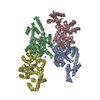

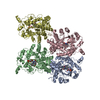
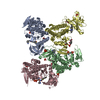
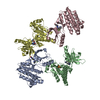

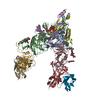






















 Z (Sec.)
Z (Sec.) Y (Row.)
Y (Row.) X (Col.)
X (Col.)

























